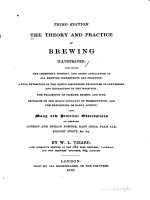Washington manual of endocrinology 3rd ed subspeciality consult
Bạn đang xem bản rút gọn của tài liệu. Xem và tải ngay bản đầy đủ của tài liệu tại đây (8.06 MB, 566 trang )
THE WASHINGTON MANUAL™
Endocrinology
Subspecialty Consult
Third Edition
Editors
Janet B. McGill, MD, MA, FACE
Professor of Medicine
Division of Endocrinology, Metabolism, and Lipid Research
Washington University School of Medicine
St. Louis, Missouri
Thomas J. Baranski, MD, PhD
Associate Professor of Medicine
Division of Endocrinology, Metabolism, and Lipid Research
Washington University School of Medicine
St. Louis, Missouri
William E. Clutter, MD
Associate Professor of Medicine
Division of Endocrinology, Metabolism, and Lipid Research
Washington University School of Medicine
St. Louis, Missouri
Series Editors
Katherine E. Henderson, MD
Assistant Professor of Clinical Medicine
Division of Medical Education
Washington University School of Medicine
2
Barnes-Jewish Hospital
St. Louis, Missouri
Thomas M. De Fer, MD
Professor of Medicine
Division of Medical Education
Washington University School of Medicine
St. Louis, Missouri
3
Senior Acquisitions Editor: Sonya Seigafuse
Senior Product Manager: Kerry Barrett
Vendor Manager: Bridgett Dougherty
Senior Marketing Manager: Kimberly Schonberger
Manufacturing Manager: Ben Rivera
Design Coordinator: Stephen Druding
Editorial Coordinator: Katie Sharp
Production Service: Aptara, Inc.
© 2013 by Department of Medicine, Washington University School of Medicine
Printed in China
All rights reserved. This book is protected by copyright. No part of this book may be reproduced in any form by
any means, including photocopying, or utilized by any information storage and retrieval system without written
permission from the copyright owner, except for brief quotations embodied in critical articles and reviews.
Materials appearing in this book prepared by individuals as part of their official duties as U.S. government
employees are not covered by the above-mentioned copyright.
Library of Congress Cataloging-in-Publication Data
The Washington manual endocrinology subspecialty consult. – 3rd ed. / editors, Thomas J. Baranski, William E.
Clutter, Janet B. McGill.
p. ; cm. – (Washington manual subspecialty consult series)
Includes bibliographical references and index.
ISBN 978-1-4511-1407-2 (alk. paper)
I. Baranski, Thomas J.II. Clutter, William E.III. McGill, Janet B. IV. Washington University (Saint Louis, Mo.).
School of Medicine. V. Title: Endocrinology subspecialty consult.VI. Series: Washington manual subspecialty
consult series.
[DNLM: 1. Endocrine System Diseases–Handbooks. 2. Metabolic Diseases–Handbooks. WK 39]
616.4’8--dc23
2012020563
The Washington Manual™ is an intent-to-use mark belonging to Washington University in St. Louis to which
international legal protection applies. The mark is used in this publication by LWW under license from Washington
University.
Care has been taken to confirm the accuracy of the information presented and to describe generally accepted
practices. However, the authors, editors, and publisher are not responsible for errors or omissions or for any
consequences from application of the information in this book and make no warranty, expressed or implied, with
respect to the currency, completeness, or accuracy of the contents of the publication. Application of the
information in a particular situation remains the professional responsibility of the practitioner.
The authors, editors, and publisher have exerted every effort to ensure that drug selection and dosage set forth
in this text are in accordance with current recommendations and practice at the time of publication. However, in
view of ongoing research, changes in government regulations, and the constant flow of information relating to drug
therapy and drug reactions, the reader is urged to check the package insert for each drug for any change in
indications and dosage and for added warnings and precautions. This is particularly important when the
recommended agent is a new or infrequently employed drug.
Some drugs and medical devices presented in the publication have Food and Drug Administration (FDA)
clearance for limited use in restricted research settings. It is the responsibility of the health care provider to
ascertain the FDA status of each drug or device planned for use in their clinical practice.
To purchase additional copies of this book, call our customer service department at (800) 638-3030 or fax orders
4
to (301) 223-2320. International customers should call (301) 223-2300.
Visit Lippincott Williams & Wilkins on the Internet: at LWW.com. Lippincott Williams & Wilkins customer
service representatives are available from 8:30 am to 6 pm, EST.
10 9 8 7 6 5 4 3 2 1
5
Contributing Authors
Ana Maria Arbelaez, MD
Assistant Professor of Pediatrics
Division of Pediatric Endocrinology and Diabetes
Washington University School of Medicine
St. Louis, Missouri
Shunzhong Bao, MD
Fellow
Division of Endocrinology, Metabolism, and Lipid Research
Washington University School of Medicine
St. Louis, Missouri
Thomas J. Baranski, MD, PhD
Associate Professor of Medicine
Division of Endocrinology, Metabolism, and Lipid Research
Washington University School of Medicine
St. Louis, Missouri
Carlos Bernal-Mizrachi, MD
Assistant Professor of Medicine
Division of Endocrinology, Metabolism, and Lipid Research
Washington University School of Medicine
St. Louis, Missouri
Kim Carmichael, MD
Associate Professor of Medicine
Division of Endocrinology, Metabolism, and Lipid Research
Washington University School of Medicine
6
St. Louis, Missouri
Sara Chowdhury, MD
Clinical Fellow
Division of Endocrinology, Metabolism, and Lipid Research
Washington University School of Medicine
St. Louis, Missouri
Roberto Civitelli, MD
Sydney M. and Stella H. Schoenberg Professor of Medicine
Professor of Orthopaedic Surgery and of Cell Biology and Physiology
Director, Bone and Mineral Diseases
Division of Endocrinology, Metabolism, and Lipid Research
Washington University School of Medicine
St. Louis, Missouri
William E. Clutter, MD
Associate Professor of Medicine
Division of Endocrinology, Metabolism, and Lipid Research
Washington University School of Medicine
St. Louis, Missouri
Philip E. Cryer, MD
Irene E. and Michael M. Karl Professor of Endocrinology and Metabolism in
Medicine
Division of Endocrinology, Metabolism, and Lipid Research
Washington University School of Medicine
St. Louis, Missouri
Kathryn Diemer, MD
Assistant Professor of Medicine
Division of Bone and Mineral Diseases
Washington University School of Medicine
St. Louis, Missouri
Judit Dunai, MD
7
Clinical Fellow
Division of Endocrinology, Metabolism, and Lipid Research
Washington University School of Medicine
St. Louis, Missouri
Simon J. Fisher, MD, PhD
Associate Professor of Medicine, Cell Biology, and Physiology
Division of Endocrinology, Metabolism, and Lipid Research
Washington University School of Medicine
St. Louis, Missouri
Stephen J. Giddings, MD, PhD
Associate Professor of Medicine
St. Louis VA Medical Center
Washington University School of Medicine
St. Louis, Missouri
Anne C. Goldberg, MD, FACP, FAHA
Associate Professor of Medicine
Division of Endocrinology, Metabolism, and Lipid Research
Washington University School of Medicine
St. Louis, Missouri
Scott Goodwin, MD
Clinical Fellow
Division of Endocrinology, Metabolism, and Lipid Research
Washington University School of Medicine
St. Louis, Missouri
Paul Hruz, MD, PhD
Associate Professor of Pediatrics
Division of Pediatric Endocrinology and Diabetes
Washington University School of Medicine
St. Louis, Missouri
Mariko Johnson, MD
8
Clinical Fellow
Division of Endocrinology, Metabolism, and Lipid Research
Washington University School of Medicine
St. Louis, Missouri
Prajesh M. Joshi, MD
Clinical Fellow
Division of Endocrinology, Metabolism, and Lipid Research
Washington University School of Medicine
St. Louis, Missouri
Kavita Juneja, MD
Clinical Fellow
Division of Endocrinology, Metabolism, and Lipid Research
Washington University School of Medicine
St. Louis, Missouri
Nadia Khoury, MD
Clinical Fellow
Division of Endocrinology, Metabolism, and Lipid Research
Washington University School of Medicine
St. Louis, Missouri
Janet B. McGill, MD, MA, FACE
Professor of Medicine
Division of Endocrinology, Metabolism, and Lipid Research
Washington University School of Medicine
St. Louis, Missouri
Dominic N. Reeds, MD
Associate Professor of Medicine
Division of Geriatrics and Nutritional Science
Washington University School of Medicine
St. Louis, Missouri
Amy E. Riek, MD
9
Instructor in Medicine
Division of Endocrinology, Metabolism, and Lipid Research
Washington University School of Medicine
St. Louis, Missouri
David A. Rometo, MD
Clinical Fellow
Division of Endocrinology, Metabolism, and Lipid Research
Washington University School of Medicine
St. Louis, Missouri
Julie Silverstein, MD
Instructor in Medicine
Division of Endocrinology, Metabolism, and Lipid Research
Washington University School of Medicine
St. Louis, Missouri
Richard I. Stein, PhD
Research Assistant Professor, Center for Human Nutrition
Behavioral Director, Weight Management Program
Washington University School of Medicine
St. Louis, Missouri
Garry Tobin, MD
Associate Professor of Medicine
Division of Endocrinology, Metabolism, and Lipid Research
Washington University School of Medicine
St. Louis, Missouri
Dwight A. Towler, MD, PhD
Lang Professor of Medicine
Division of Endocrinology, Metabolism, and Lipid Research
Washington University School of Medicine
St. Louis, Missouri
Zhiyu Wang, MD, PhD
10
Clinical Fellow
Division of Endocrinology, Metabolism, and Lipid Research
Washington University School of Medicine
St. Louis, Missouri
Michael P. Whyte, MD
Professor of Medicine, Pediatrics, and Genetics
Division of Bone and Mineral Diseases
Washington University School of Medicine
Medical-Scientific Director, Center for Metabolic Bone Disease and Molecular
Research, Shriners Hospitals for Children, St. Louis
St. Louis, Missouri
Kevin Yarasheski, PhD
Professor of Medicine, Cell Biology, and Physiology, and Physical Therapy
Division of Endocrinology, Metabolism, and Lipid Research
Washington University School of Medicine
St. Louis, Missouri
11
Chairman’s Note
is a pleasure to present the new edition of The Washington Manual ™
ItSubspecialty
Consult Series: Endocrinology Subspecialty Consult. This pocketsize book continues to be a primary reference for medical students, interns,
residents, and other practitioners who need ready access to practical clinical
information to diagnose and treat patients with a wide variety of disorders. Medical
knowledge continues to increase at an astounding rate, which creates a challenge for
physicians to keep up with the biomedical discoveries, genetic and genomic
information, and novel therapeutics that can positively impact patient outcomes. The
Washington Manual Subspecialty Series addresses this challenge by concisely and
practically providing current scientific information for clinicians to aid them in the
diagnosis, investigation, and treatment of common medical conditions.
I want to personally thank the authors, which include house officers, fellows, and
attendings at Washington University School of Medicine and Barnes Jewish
Hospital. Their commitment to patient care and education is unsurpassed, and their
efforts and skill in compiling this manual are evident in the quality of the final
product. In particular, I would like to acknowledge our editors, Drs. Thomas J.
Baranski, William E. Clutter, and Janet B. McGill, and the series editors, Drs.
Katherine Henderson and Tom De Fer, who have worked tirelessly to produce
another outstanding edition of this manual. I would also like to thank Dr. Melvin
Blanchard, Chief of the Division of Medical Education in the Department at of
Medicine at Washington University School of Medicine, for his advice and
guidance. I believe this Subspecialty Manual will meet its desired goal of providing
practical knowledge that can be directly applied at the bedside and in outpatient
settings to improve patient care.
Victoria J. Fraser, MD
Dr. J. William Campbell Professor
Interim Chairman of Medicine
Co-Director of the Infectious Disease Division
Washington University School of Medicine
12
Preface
third edition of The Washington Manual ™ Endocrinology Subspecialty
This
Consult was written by Washington University endocrine fellows and faculty
members. The manual is designed to serve as a guide for students, house staff, and
fellows involved in inpatient and outpatient endocrinology consults. It is not meant
to serve as a comprehensive review of the field of endocrinology. Rather, it focuses
on practical approaches to endocrine disorders commonly seen in consultation, with
emphasis on key components of evaluation and treatment.
Several changes in content were made with the third edition. All chapters have
been updated to provide the latest information on the pathophysiology and treatment
of endocrine disorders. A new chapter has been added that covers Inpatient
Management of Diabetes. Drug dosing information was reviewed and updated in
each chapter. Clinical pearls are highlighted in boldfaced text within the chapters.
We are indebted to the remarkable efforts of the fellows and attending physicians
who contributed to the current edition of this manual and worked enthusiastically to
provide high-quality, contemporary, concise chapters.
TJB
WEC
JBM
13
Contents
Contributing Authors
Chairman’s Note
Preface
PART I. HYPOTHALAMIC AND PITUITARY DISORDERS
1 Pituitary Adenomas
Zhiyu Wang and Julie Silverstein
2 Prolactinoma
Mariko Johnson and Julie Silverstein
3 Acromegaly
Nadia Khoury and Julie Silverstein
4 Diabetes Insipidus
Prajesh M. Joshi and Julie Silverstein
5 Syndrome of Inappropriate Antidiuretic Hormone
Scott Goodwin and Thomas J. Baranski
PART II. THYROID DISORDERS
6 Evaluation of Thyroid Function
William E. Clutter
7 Euthyroid Goitor and Thyroid Nodules
William E. Clutter
8 Hyperthyroidism
William E. Clutter
9 Hypothyroidism
William E. Clutter
14
PART III. ADRENAL DISORDERS
10 Adrenal Incidentaloma
Shunzhong Bao and Simon J. Fisher
11 Adrenal Insufficiency
Zhiyu Wang and Kim Carmichael
12 Adult Congenital Adrenal Hyperplasia
Judit Dunai and Kim Carmichael
13 Conn’s Syndrome
Mariko Johnson and Thomas J. Baranski
14 Cushing’s Syndrome
Scott Goodwin and Julie Silverstein
15 Pheochromocytoma
Prajesh M. Joshi and Simon J. Fisher
PART IV. GONADAL DISORDERS
16 Amenorrhea
Sara Chowdhury and Amy E. Riek
17 Gynecomastia
Scott Goodwin and Simon J. Fisher
18 Hirsutism
Mariko Johnson and Kim Carmichael
19 Male Hypogonadism
Shunzhong Bao and Stephen J. Giddings
20 Polycystic Ovary Syndrome
Nadia Khoury and Janet B. McGill
PART V. DISORDERS OF BONE AND MINERAL METABOLISM
21 Hypercalcemia
Nadia Khoury and Kim Carmichael
22 Hyperparathyroidism
Shunzhong Bao and Dwight A. Towler
23 Hypocalcemia
Prajesh M. Joshi and Michael P. Whyte
15
24 Vitamin D Deficiency
Amy E. Riek, Ana Maria Arbelaez, and Carlos Bernal-Mizrachi
25 Osteoporosis
Amy E. Riek, Kathryn Diemer, and Roberto Civitelli
26 Paget’s Disease of Bone
Scott Goodwin and Michael P. Whyte
PART VI. DISORDERS OF FUEL METABOLISM
27 Standards of Care for Diabetes Mellitus
Prajesh M. Joshi and Janet B. McGill
28 Diabetes Mellitus Type 1
Judit Dunai and Janet B. McGill
29 Diabetes Mellitus Type 2
Zhiyu Wang and Janet B. McGill
30 Inpatient Management of Diabetes
David A. Rometo and Garry Tobin
31 Hypoglycemia
Nadia Khoury and Philip E. Cryer
32 Obesity
David A. Rometo, Dominic N. Reeds, and Richard I. Stein
33 Dyslipidemia
Mariko Johnson and Anne C. Goldberg
PART VII. NEOPLASMS
34 Multiple Endocrine Neoplasia Syndromes
Shunzhong Bao and Thomas J. Baranski
35 Carcinoid Syndrome
Judit Dunai and Thomas J. Baranski
36 Polyendocrine Syndromes
Prajesh M. Joshi, Kavita Juneja, and Janet B. McGill
37 Endocrine Disorders in HIV/AIDS
Scott Goodwin, Paul Hruz, and Kevin Yarasheski
Index
16
17
1
Pituitary Adenomas
Zhiyu Wang and Julie Silverstein
GENERAL PRINCIPLES
Pituitary adenomas are benign neoplasms arising in the adenohypophysial cells.
Pituitary tumors constitute 10% of intracranial tumors.
The most frequent primary pituitary tumors are pituitary adenomas.
Pituitary adenomas occur in 10% to 15% of the general population1 and are
usually benign.
Most pituitary adenomas are sporadic, but some arise as a component of genetic
syndromes.
Pituitary carcinomas are rare.2
Classification
According to the tumor size, pituitary adenomas are classified as microadenomas
(<10 mm in greatest diameter) or macroadenomas (≥10 mm in greatest diameter).
Depending on the cell of origin, they can be hormone-producing, or functionally
inactive (Table 1-1).3
Etiology
Pituitary adenomas arise as a result of monoclonal pituitary cell proliferation.
Several different mutations have been associated with pituitary adenomas.4
Activating gsp mutations are present in 40% of GH-secreting adenomas. These are
point mutations of the G protein alpha subunit (Gs alpha) gene, which activate Gs
alpha protein and increase cyclic adenosine monophosphate (cAMP) levels,
leading to GH hypersecretion and cell proliferation.
H-ras gene mutations have been identified in metastatic pituitary carcinomas.
Pituitary tumor transforming gene (PTTG) is abundant in all pituitary tumor types,
especially prolactinomas.
A truncated form of FGFR-4 is immunodetected in about a third of prolactinomas.
18
Multiple endocrine neoplasia type 1 (MEN-1) is characterized by combined tumor
formation or hyperfunction of pancreatic islets, anterior pituitary, and parathyroid
glands.
Carney’s complex is characterized by pituitary adenomas, cardiac myxomas,
schwannomas, and thyroid adenomas with spotty skin pigmentation.
Hypothalamic factors may promote and maintain growth of transformed pituitary
adenomatous cells. There is emerging data that dysregulation of cell-cycle control
proteins, and loss of reticulin network play a role in pituitary tumor formation.4
TABLE 1-1 FUNCTIONAL CLASSIFICATION OF PITUITARY ADENOMAS
DIAGNOSIS
Clinical Presentation
The clinical presentation of pituitary adenomas depends on whether or not the
tumor is hormonally functional or nonfunctional and on whether or not there is
mass effect or hemorrhage.
19
The diagnosis is sometimes made when a pituitary tumor is found incidentally on
imaging studies performed for other reasons.5
Hormonal Hypersecretion
Prolactinomas (see Chapter 2, Prolactinoma)
Hyperprolactinemia causes hypogonadism in men and premenopausal women.
Men present with decreased libido and impotence. Women often present with
abnormal menses or infertility and galactorrhea.6 There is often a delay in the
diagnosis in postmenopausal women due to lack of clinical manifestations.
Somatotroph adenomas (see Chapter 3, Acromegaly)
Acromegaly is growth hormone oversecretion occurring in the postpubertal phase
of life. Gigantism is growth hormone excess that occurs before fusion of the
epiphyseal growth plates in children or adolescents. Acromegaly is characterized
by skeletal overgrowth and soft tissue enlargement. Acromegalic patients have an
increase in mortality related to associated cardiovascular, respiratory,
gastrointestinal, and metabolic disorders.7 The onset of acromegaly is insidious
and often results in a delay in diagnosis.
Corticotroph adenomas (see Chapter 14, Cushing’s Syndrome)
ACTH–secreting tumors cause Cushing’s disease. 8 The classic symptoms and
signs of hypercortisolism are not always present and are often not specific.
Obesity (predominantly central fat distribution), hypertension, glucose intolerance
or diabetes, hirsutism, and gonadal dysfunction are common. Hypercortisolism
produces skin thinning, easy bruising, abdominal striae, and proximal muscle
weakness (inability to climb stairs or rise from a deep chair). Psychiatric
abnormalities occur in 50% of patients (depression, lethargy, paranoia, and
psychosis). Long-standing Cushing’s disease can cause osteoporosis and aseptic
necrosis of the femoral and humeral heads. Patients may present with poor wound
healing and frequent superficial fungal infections.
Thyrotroph adenomas
Hyperthyroidism due to a TSH-secreting pituitary adenoma is very rare.9
Thyrotroph adenomas usually present as large macroadenomas, and >60% are
locally invasive.
Gonadotroph adenomas
Gonadotroph adenomas are usually macroadenomas and present with visual
disturbances, symptoms of hypopituitarism or headache.10 Most are clinically
nonfunctioning.
Hormonal Hyposecretion (Hypopituitarism)
20
Hypopituitarism can be a result of any hypothalamic or pituitary lesion.11
Gonadotrophs are most commonly affected. Patients present with hypogonadism
with low or inappropriately normal FSH and/or LH levels (secondary
hypogonadism).
Corticotrophs and thyrotrophs are most resistant to mass effects and the last to lose
function. TSH or ACTH deficiency usually indicates panhypopituitarism. ACTH
deficiency causes secondary adrenal insufficiency. TSH deficiency causes
secondary hypothyroidism.
GH deficiency is often present when two or more other hormones are deficient.
Prolactin deficiency is rare and occurs when the anterior pituitary is completely
destroyed, as in apoplexy.
Mass Effect
Local effects are closely related to the size and location of the adenoma.
Headaches are common and may not correlate with the size of the adenoma.
Visual defects are also common.
Upward compression and pressure on the optic chiasm may result in bitemporal
hemianopsia, loss of red perception, scotomas, and blindness.
Lateral invasion may impinge on the cavernous sinus, leading to lesions of the
III, IV, VI, and V1 cranial nerves, causing diplopia, ptosis, ophthalmoplegia,
and facial numbness.
Direct hypothalamic involvement may cause several endocrine disorders such as:
Diabetes insipidus (see Chapter 4, Diabetes Insipidus).
Appetite/behavioral disorders (obesity, hyperphagia, anorexia, adipsia, and
compulsive drinking).
Sleep and temperature dysregulation.
Cerebrospinal fluid rhinorrhea, caused by inferior extension of the adenoma, is a
very rare presentation.
Uncinate seizures, personality disorders, and anosmia can occur if temporal and
frontal brain lobes are invaded by the expanding parasellar mass.
Pituitary Apoplexy
Pituitary apoplexy is an endocrine emergency, often resulting from spontaneous
hemorrhage and/or infarction of a rapidly growing or large pituitary adenoma.12
Symptoms include severe headache, neck stiffness, progressive cranial nerve
damage, bilateral visual disturbances, change in consciousness, cardiovascular
21
collapse, and coma. Acute adrenal insufficiency may also occur. Patients may
experience long-term pituitary insufficiency.
Pituitary imaging reveals intraadenomal hemorrhage and stalk deviation.
Differential Diagnosis
For a list of common sellar and parasellar masses, see Table 1-2.
Sellar/parasellar cysts
Craniopharyngiomas are the most common and are calcified, cystic,
suprasellar tumors arising from embryonic squamous cell rests of Rathke’s
cleft. Craniopharyngiomas have a bimodal peak of incidence, occurring
predominantly in children between the ages of 5 and 10 years; a second peak
occurs in late middle age.13 Craniopharyngiomas are slow growing. Large
craniopharyngiomas can obstruct CSF flow and cause increased intracranial
pressure. Children present with headache, vomiting, visual field deficits, and
growth failure. Adults may present with neurologic symptoms, anterior pituitary
hormone deficits, and DI.
Rathke’s cleft cysts are benign, noncalcified lesions that mimic hormonally
inactive adenomas or craniopharyngiomas. They have a particularly low
recurrence rate after partial excision.
Pituitary granulomas
Sarcoidosis of the hypothalamic-pituitary region occurs in most patients with
CNS involvement and can cause hypopituitarism with or without symptoms of
an intrasellar mass. Sarcoidosis has a predilection for the hypothalamus,
posterior pituitary, and cranial nerves.14 The most common hormonal
abnormalities are hypogonadotropic hypogonadism, mild hyperprolactinemia,
and DI.
Langerhans’ cell histiocytosis (LCH)
Langerhans’ histiocytosis is characterized by infiltration of dendtritic cells
(Langerhans’ cells). 15 It can be unifocal or multifocal and affect multiple
sites, such as bone, skin, lung, pituitary, hypothalamus, liver, and spleen.
LCH occurs more often in children and is almost always associated with
diabetes insipidus. Anterior pituitary dysfunction occurs in 20% of
patients.16
Hand–Schüller–Christian (HSC) disease includes the triad of DI,
exophthalmos, and lytic bone disease. Other features of the disease include
axillary skin rash and a history of recurrent pneumothorax. Children can
present with growth retardation and anterior pituitary hormone deficits.
22
MRI may reveal a thickened pituitary stalk or a diminished posterior pituitary
bright spot, and possibly bone lesions.
Hypophysitis is characterized by either focal or diffuse infiltration of the pituitary
by inflammatory cells.17
Lymphocytic hypophysitis affects mostly women in late pregnancy or during
the postpartum period. Other autoimmune diseases (autoimmune thyroiditis)
may also be present. The diagnosis is confirmed by histology or resolution of
the mass over time. Partial recovery of pituitary function and resolution of the
sellar mass can occur spontaneously or with use of corticosteroids and
hormone replacement.
Granulomatous hypophysitis is not usually associated with pregnancy.
Pituitary histology shows features of chronic inflammation and granulomas.
Pituitary hyperplasia usually presents as generalized enlargement of the
pituitary.18 Pituitary hyperplasia may be caused by:
Lactotroph hyperplasia during pregnancy
Thyrotroph hyperplasia secondary to long-standing primary hypothyroidism
Gonadotroph hyperplasia in long-standing primary hypogonadism
Very rarely, somatotroph hyperplasia in ectopic secretion of growth hormonereleasing hormone (GHRH)
TABLE 1-2 COMMON SELLAR AND PARASELLAR MASSES
23
Pituitary metastases most commonly arise from breast carcinomas (women) and
lung carcinomas. A rapidly enlarging mass is highly suggestive of a metastatic
lesion.19
Pituitary carcinomas are rare.19 They may produce GH, ACTH, or prolactin, or
they may be clinically nonfunctioning. The diagnosis can only be established when
the lesion metastasizes.
Diagnostic Testing
Laboratories
Hormonal hypersecretion
Prolactinoma
Serum prolactin levels are usually proportional to the tumor mass. Values are
24
generally >250 ng/mL in macroprolactinomas.6
Hyperprolactinemia between 20 and 200 ng/mL can be due to
microprolactinomas, stalk compression from a sellar masse, medication
induced hyperprolactinemia, or due to the “hook effect” (see Chapter 2,
Prolactinoma).
Acromegaly
GH secretion in normal subjects is pulsatile, diurnal, and affected by a
variety of factors.7
The initial laboratory tests to be ordered in a patient suspected of having
acromegaly should be IGF-1 and GH levels. Current guidelines recommend
an elevated IGF-1 and failure to suppress GH during an oral glucose
tolerance test (OGTT) to confirm the diagnosis (see Chapter 3, Acromegaly).
Cushing’s disease
Patients with clinical signs or symptoms of Cushing’s syndrome should be
screened for Cushing’s disease with either a 24-hour urine free cortisol, a
low-dose dexamethasone suppression test, or a late-night salivary cortisol.8
An elevated ACTH level in the setting of biochemically confirmed Cushing’s
syndrome suggests either a pituitary source (Cushing’s disease) or ectopic
ACTH syndrome. A high-dose dexamethasone suppression test and/or
inferior petrosal sinus sampling (IPSS) can be used to differentiate between
the two (see Chapter 14, Cushing’s Syndrome).
TSH-secreting adenomas
Elevated thyroid hormone levels in the setting of an elevated or
inappropriately normal TSH suggests the diagnosis.9 An elevated pituitary
glycoprotein hormone alpha-subunit (α-GSU) may be present.
Similar laboratory values may be seen in the presence of circulating
antibodies against TSH. Therefore, a methodologic interference in the
measurement of TSH must be ruled out. Dynamic testing, such as T3
suppression and TRH stimulation can be used to differentiate a TSHsecreting adenoma from thyroid hormone resistance syndromes.
Gonadotroph adenomas
Most non-functioning pituitary adenomas arise from gonadotroph cells.
Although circulating LH and FSH levels may be elevated in a minority of
patients, this is rarely clinically significant.
Hypopituitarism
Corticotropin deficiency (secondary adrenal insufficiency)
25









